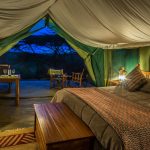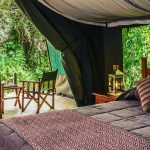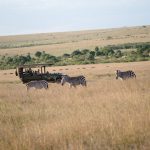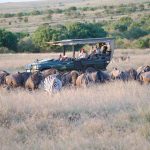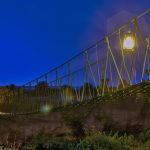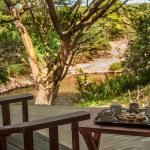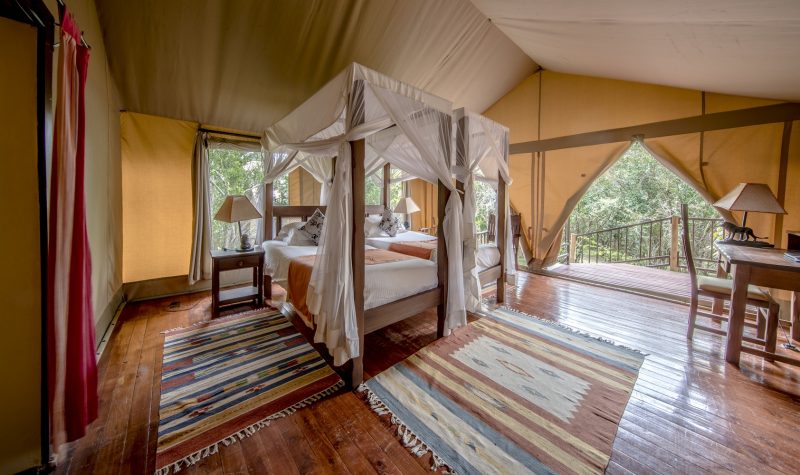Shs. 25,500/- full-board and Shs. 32,500/- ground package per person per night at Ilkeliani Mara Camp
Valid until 31 May 2025
Full-boardDouble: Shs. 25,500/- per person per night Single: Shs. 31,880/- per night |
Ground packageDouble: Shs. 32,500/- per person per night Single: Shs. 40,630/- per night |
Children:0 to 2 years – free 2 to 11 sharing with adults – 50% of adult rate 2 to 11 in own tent – 75% of adult rate 1 adult and 1 child – single + 75% of adult rate |
To book this package please fill out the following form or simply email us on safaris@safari-center.com
Ilkeliani Mara Camp
Nestled in a river glade in Maasai Mara game reserve, the area is where elephants come to drink from the Talek river. The camp has been designed to combine the old safari style with a modern and fresh feel. Ilkeliani camp offers only 17 tents with views of the plains and the wildlife action throughout the day. It is an eco-friendly camp. The ethos is to leave a minimum foot print on nature. Each tent is stylish with en suite bathroom. They are sited under its own cluster of shady trees and you do feel that you are out in the wilderness. The interiors are spacious featuring a front verandah with a day bed and canvas safari chairs. Home cooked meals combined with personal service contribute to the safari experience.
The experience
Rise early and go on a walking safari or dawn game drive, returning to the camp in time for breakfast. Or if you on a safari game drive with your own driver-guide exploring Maasai Mara national reserve, perhaps to the Mara river or Musiara Marsh on half day with picnic breakfast. Return to the camp in time for lunch, followed by a rest in the shaded tent or relax in the veranda of your tent, watching the game go by. One can choose to go on an afternoon game drive returning to camp in time for a shower, followed by a sundowner round the campfire, exchanging stories of the day with the other guests. Dinner by candlelight completes the day, after which an askari will guide you to your tent.
Alternate experience
Maasai Mara
Wildlife
Wildlife is abundant in the area and game-viewing is good any time of year, peaking from July to October. Besides large numbers of other plains game including zebra, different species of antelopes, giraffe and warthog, there are many prides of lions, which follow the herds, but some are resident in the area all year round. Mara is a perfect kingdom for these lions, the most powerful of hunters, who dominate the grasslands. Cheetahs, spotted and striped hyena, and smaller predators including all three types of jackal also roam the Mara area. Leopard tend to be but territorial and thus our guides know where to find them. To complete the big five list, elephant, buffalo and the rhino can also usually be found. Hippo and crocodiles abound in the Mara and Talek rivers.
Birds
There is also a wealth of bird-life: Over 550 species have been recorded, including the migrant species who visit during the European winter. Raptors are abundant including some large eagles. Meanwhile smaller birds continue to delight amateurs, while rarer species impress the experts. Butterflies, many species of insects and arachnids, including the Golden Orb spider are also interesting. There are also many species of trees, shrubs and grasses, many of which are used medicinally by the local Maasai. After the rains the wildflowers dot the plains and forests with colour, many of them rare species.
Background
Several hundred years before the coming of the first Europeans in the late 1800’s the Maasai had migrated into Kenya down the Nile valley. It wasn’t until 1948 that the Mara area became a national game reserve. Today Maasai Mara is under the control of the local Narok county council and local community group ranches. Maasai Mara remains most famous for its annual migration. One of the most extraordinary natural events on the planet, the great migration involves a mass movement of ungulates, most notably the wildebeest.
Maasai
Karen Blixen, writer of Out of Africa, wrote home to Denmark early last century full of admiration for the tall handsome Maasai. Another early white settler, writer Elspeth Huxley described them as the tribe that shared these enormous, sun-drenched plains with the wild animals. The Maasai have remained dominant in the Mara area, while being encouraged to protect the ecosystem and wildlife. Your visit to the Mara will re-enforce and promote the necessity for this. The Maasai, who are fierce warriors, have largely remained very independent people, many of whom still adhere to their values and lifestyle. The Maasai never hunted, but lived peacefully alongside the wildlife in harmony. This continued co-existence makes Maasai Mara one of the world’s most interesting and unique wilderness regions.
Migration
Towards the beginning of every July vast numbers of these curious looking creatures move en masse from the southern plains of the Serengeti in Tanzania to cross the Mara river and head north in search of the green flush of grasses watered by Kenya’s long rains of April and early May. It is estimated that more than half a million wildebeest enter the reserve each year, followed by large numbers of zebras. Those who haven’t drowned in the river, been torn apart by crocodiles, or brought down by the big cats will dutifully return south around October to the now-greener pastures of Tanzania, leaving the Mara’s dusty plains to recover with the onset of the short rains in November.
Do or die
As millions of hooves annually trample a circular route around Mara in search of greener pastures and water, this powerful migratory instinct overrides any fear of the dangers of crossing the Mara River. During the migrations the river banks witness daily dramas as the wildebeest wrestle rapids and currents. Even more probable than drowning is ending their journey in the cruel jaws of the crocodiles, who lurk beneath the mud-brown surface of the churning waters, awaiting their chance.
Guides
The staff at ilkeliani camp have been hired from the surrounding villages and educated in the art of service. Most of the staff have a minimum primary school education. Some hold higher level degrees. Many of the staff have been at the camp for a number of years and speak a variety of languages including English, Kiswahili and their local tribal.
We work with the locals
We employ local Maasai driver-guides, trained to a high standard. They have grown up in the area and have a talent for spotting game and reading animal spoor, as well as signs of a natural event, be it a river crossing or a predator kill. The guides will be also be happy to share their background with you, and may even take you outside the reserve to visit their Maasai homesteads, depending on your day’s game viewing schedule.
Culture
Community support
Ilkeliani assists the Maasais of the game reserve in conserving their wildlife and environment. The Maasais receive a bed night fee for every guest night in the camp. Unlike most camps in the Mara who charge their clients an extra hidden fee, we give directly from our profits. This enables them to benefit from their natural resources so to better able to care for their families and improve their standard of living. Guests from time to time help with donations and contributions and Ilkeliani channels them to their appropriate causes.
Pack for a purpose
Birding
Birding at Ilkeliani camp will be rewarding for both amateurs and experts. An early morning will quickly reveal White-browed Robin-Chat, African Paradise Flycatchers, Slate-coloured Boubou and Grey-backed Camaroptera, all of which are common around the tented accommodation. Along the Talek River in front of the camp, it is common to find the golden weaver, common sandpiper, African pied wagtail, grey-headed Malachite and woodland kingfishers. The ubiquitous Egyptian geese are also sure to make an appearance. Look up and try to pick out little and white-rumped Swifts, Brown-throated and Banded Martins, Mosque and lesser striped swallows and then black and white-headed saw-wings.








